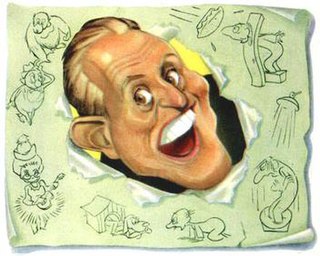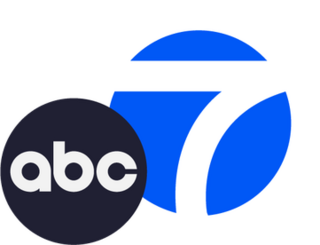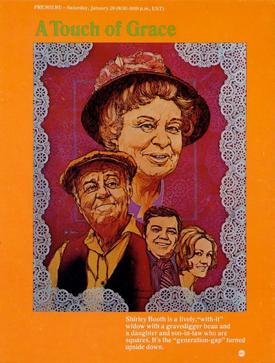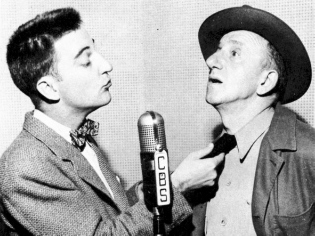Related Research Articles
The year 1964 in television involved some significant events. Below is a list of television-related events which occurred in that year.
The year 1954 in television involved some significant events. Below is a list of television-related events in 1954.
The year 1948 in television involved some significant events. Below is a list of television-related events during 1948.

The Arthur Murray Party is an American television variety show that ran from July 1950 until September 1960. The show was hosted by dancers Arthur and Kathryn Murray, the show featured various acts and celebrity guests and acted as advertisement for their chain of dance studios. Each week, the couple performed a mystery dance, and the viewer who correctly identified the dance would receive two free lessons at a local studio.

House Party is an American radio daytime variety/talk show that aired on CBS Radio and on ABC Radio from January 15, 1945 to October 13, 1967. The show also had a long run on CBS Television as Art Linkletter's House Party and, in its final season, The Linkletter Show, airing from September 1, 1952 to September 5, 1969.

KGO-TV is a television station licensed to San Francisco, California, United States, serving as the San Francisco Bay Area's ABC network outlet. It has been owned and operated by the network's ABC Owned Television Stations division since the station's inception. KGO-TV's studios are located at the ABC Broadcast Center immediately west of The Embarcadero north of the city's Financial District, and its transmitter is located atop Sutro Tower. In addition, KGO-TV leases part of its building to CW outlet KRON-TV, but with completely separate operations.
The 1955–56 network television schedule for the four major English language commercial broadcast networks in the United States. The schedule covers primetime hours from September 1955 through March 1956. The schedule is followed by a list per network of returning series, new series, and series cancelled after the 1954–55 season.
The following is the 1950–51 network television schedule for the four major English language commercial broadcast networks in the United States. The schedule covers primetime hours from September 1950 through March 1951. The schedule is followed by a list per network of returning series, new series, and series cancelled after the 1949–50 season. This season became the first in which primetime was entirely covered by the networks. It was also the inaugural season of the Nielsen rating system. Late in the season, the coast-to-coast link was in service.
The 1948–49 network television schedule for the four major English language commercial broadcast networks in the United States. The schedule covers primetime hours from September 1948 through March 1949. The schedule is followed by a list per network of returning series, new series, and series cancelled after the 1947–48 season. This was the first season in which all four networks then in operation in the United States offered nightly prime time schedules Monday through Friday.
The 1949–50 network television schedule for the four major English language commercial broadcast networks in the United States. The schedule covers primetime hours from September 1949 through March 1950. The schedule is followed by a list per network of returning series, new series, and series cancelled after the 1948–49 season. This was the first season in which all four networks offered at least some prime time programming all seven nights of the week.
The Morey Amsterdam Show is an American sitcom which ran from 1948 to 1949 on CBS Television and 1949–50 on the DuMont Television Network, for a total of 71 episodes.

Ford Theatre, spelled Ford Theater for the original radio version and known, in full, as The Ford Television Theatre for the TV version, is a radio and television anthology series broadcast in the United States in the 1940s and 1950s. At various times the television series appeared on all three major television networks, while the radio version was broadcast on two separate networks and on two separate coasts. Ford Theatre was named for its sponsor, the Ford Motor Company, which had an earlier success with its concert music series, The Ford Sunday Evening Hour (1934–42).

The Danny Kaye Show is an American variety show, hosted by the stage and screen star Danny Kaye, which aired on Wednesday nights from September 25, 1963, to June 7, 1967, on the CBS television network. Directed by Robert Scheerer, it premiered in black-and-white. It switched to color broadcasts in the fall of 1965. At the time, Kaye was at the height of his popularity. He starred in a string of successful 1940s and 1950s musical comedy features, made numerous personal appearances at venues such as the London Palladium, and his rare selective visits to the small screen were considered major events. With his recent motion pictures considered disappointments, three triumphant early 1960s television specials led the way to this series. Prior to his film and television career, Kaye had made a name for himself with his own radio show, also titled The Danny Kaye Show. He made numerous guest appearances on other comedy and variety radio shows and headlined in several major Broadway musical revues throughout the 1940s.
Fashions on Parade is an American fashion-themed television series that aired on the DuMont Television Network from November 4, 1948, to April 24, 1949, and on ABC from April 27, 1949, to June 29, 1949. The show was hosted by Adelaide Hawley.
The Ed Wynn Show is an American variety show originally broadcast from September 22, 1949 to July 4, 1950, on the CBS Television Network. Comedian and former vaudevillian Ed Wynn was the star of the program's 39 episodes, which were the first shows broadcast live from Hollywood, and transmitted via kinescope to New York.

The Alan Dale Show is an early American television program which ran on the DuMont Television Network in 1948, and then on CBS Television from 1950-1951.
The Chevrolet Tele-Theatre is an American anthology series that aired live on NBC Mondays at 8 pm EST from September 27, 1948 to June 26, 1950. The program presented both news headlines and live dramatic performances of either original plays or works adapted for television from the stage. Sometimes the show was referred to as Chevrolet on Broadway or The Broadway Playhouse; particularly when the program was presenting an adapted stage work from New York City's theatre scene.

A Touch of Grace is an American sitcom that was based on the British series For the Love of Ada starring Shirley Booth and J. Patrick O'Malley centering on a widow who moves in with her daughter and son-in-law and her romantic relationship with an elderly man. It aired on ABC from January 20 to April 21, 1973.

The Durante-Moore Show was an old-time radio show that ran on NBC with episodes running from March 25, 1943–October 28, 1943 and on CBS with episodes running from October 8, 1943–June 27, 1947.
References
- ↑ Terrace, Vincent (2009). Encyclopedia of Television Shows, 1925 through 2007 (Volume 1). Jefferson, North Carolina: McFarland & Company, Inc. ISBN 978-0-7864-3305-6.
- ↑ "CBS Surprises, Goes Outside For 'Studio'". Billboard. November 5, 1949. p. 7. Retrieved December 17, 2023.
- ↑ McNeil, Alex (1996). Total Television: the Comprehensive Guide to Programming from 1948 to the Present (4th ed.). New York, New York: Penguin Books USA, Inc. p. 14. ISBN 0-14-02-4916-8.
- ↑ Brooks, Tim; Marsh, Earle F. (24 June 2009). The Complete Directory to Prime Time Network and Cable TV Shows, 1946-Present. Random House Publishing Group. p. 12. ISBN 978-0-307-48320-1 . Retrieved May 25, 2022.
- ↑ "Radio and Television: Peabody Awards Presented at Hotel Roosevelt -- Two Video Shows Are Honored" . The New York Times. April 22, 1949. p. 46. Retrieved May 25, 2022.
- ↑ "Radio and Television: C. B. S. Video Network to Offer Tuesdays 'Actor's Studio,' Dropped by A. B. C." . The New York Times. October 29, 1949. p. 28. Retrieved June 16, 2022.
- ↑ "Dramatic Shows". Ross Reports on Television including The Television Index. November 27, 1949. p. 5. Retrieved January 31, 2023.
- ↑ Hawes, William (November 16, 2015). Live Television Drama, 1946-1951. McFarland. pp. 34–35. ISBN 978-1-4766-0849-5 . Retrieved June 7, 2022.
- 1 2 "Tele Follow-up Comment". Variety. January 12, 1949. p. 30. Retrieved January 3, 2023.
- ↑ "Tele Follow-up Comment". Variety. January 26, 1949. p. 36. Retrieved January 16, 2023.
- ↑ "Radio and Television: ' Actors' Studio' Returns to ABC Video Chain Sept. 28 With 'The Canterville Ghost'" . The New York Times. September 20, 1949. p. 58. Retrieved May 25, 2022.